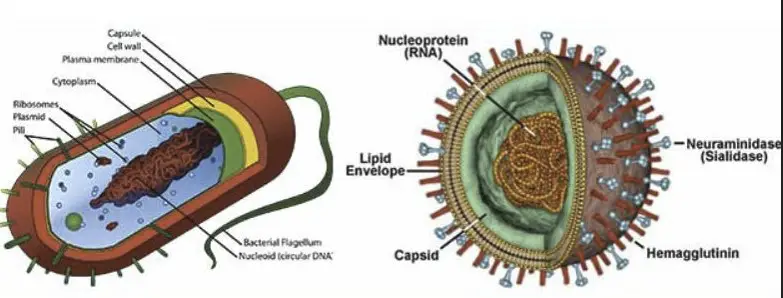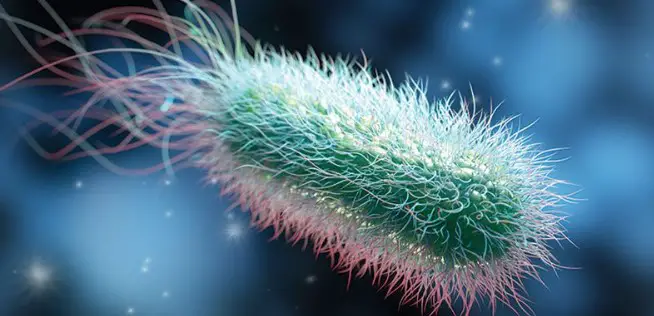Bacteria and viruses are two fundamental entities in the study of biology and medicine, each playing distinct roles in health and disease. These microscopic organisms are ubiquitous, influencing everything from medicine to environmental science. Though often mentioned in the same breath due to their microscopic size and potential to cause disease, their differences are profound and critical to understand.
Bacteria are single-celled organisms that thrive in many environments. They possess simple cellular structures with a rigid cell wall, and most importantly, they reproduce independently. Viruses, on the other hand, are much smaller and cannot survive or reproduce without a host. They invade living cells and use the host’s machinery to multiply, often harming the host in the process.
Understanding the fundamental differences between bacteria and viruses is essential for developing effective treatments and preventative measures. Each has a unique structure, genetic makeup, and interaction with living environments, leading to varied implications for human health and disease.

Defining Bacteria
Basic Characteristics
Bacteria are single-celled microorganisms that are essential components of the biosphere and have significant roles in various environmental, industrial, and health contexts. These organisms display a variety of shapes, including spherical (cocci), rod-shaped (bacilli), and spiral (spirilla) forms. Unlike cells of animals and plants, bacterial cells do not have a nucleus and other membrane-bound organelles. Instead, their genetic material is contained in a single, circular strand of DNA located in a centralized area of the cell known as the nucleoid.
Types of Bacteria
Bacteria are incredibly diverse, classified into numerous types based on factors such as their energy sources, the environments they thrive in, and their shapes. Commonly recognized groups include:
- Aerobic bacteria: These require oxygen to survive.
- Anaerobic bacteria: These can live without oxygen.
- Pathogenic bacteria: Known to cause diseases.
- Non-pathogenic bacteria: Typically harmless and can be beneficial.
Defining Viruses
Basic Characteristics
Viruses are much smaller than bacteria and are considered by many scientists to be at the edge of living organisms because they cannot reproduce or carry out metabolic processes on their own. A virus is essentially a protein shell around genetic material, either DNA or RNA, and requires a host cell to replicate. Viruses are known for their simple structure, which includes a capsid (protein coat) and sometimes a lipid envelope derived from the host cell.
Types of Viruses
Viruses vary widely depending on their host organism, mode of transmission, and the diseases they cause. Some of the well-known types include:
- Influenza viruses: Cause seasonal flu.
- Retroviruses: Such as HIV, which integrates its DNA into the host genome.
- Coronaviruses: Includes SARS-CoV-2, responsible for COVID-19.
Size and Structure
Comparative Size
Bacteria and viruses differ significantly in size. Bacteria are typically much larger, usually around 0.5-5 micrometers in length. In contrast, viruses are smaller, generally ranging from 20 to 300 nanometers, making most viruses invisible under traditional light microscopes.
Structural Complexity
Bacteria are complex in structure compared to viruses. They possess cell walls, ribosomes for protein synthesis, and in some cases, structures like flagella or pili for movement and attachment. Viruses lack these cellular components and structures, having only a protective coating and genetic material.
Reproduction Methods
Bacteria Replication
Bacteria reproduce through a process known as binary fission, where a single bacterial cell divides into two identical progeny cells. This process can occur rapidly under optimal conditions, leading to exponential growth. Key steps include:
- DNA replication
- Cell wall and plasma membrane division
- Separation into two cells
Virus Replication
Virus replication involves several key steps, which occur inside the host cell:
- Attachment: The virus attaches to the host cell.
- Penetration: The viral DNA or RNA enters the host cell.
- Synthesis: The host cell’s machinery is used to make viral components.
- Assembly: New viruses are assembled from the newly synthesized components.
- Release: New viruses exit the host cell, often destroying it.
Genetic Material
DNA and RNA in Bacteria
Bacteria typically contain a single circular chromosome of DNA, although some may also have small, additional DNA strands called plasmids. These plasmids can be transferred between bacteria and often carry genes that confer advantageous traits, such as antibiotic resistance.
DNA and RNA in Viruses
Viruses can have either DNA or RNA as their genetic material, and this can be single-stranded or double-stranded. The type of nucleic acid determines the virus’s replication method and its approach to manipulating the host’s cellular machinery.
Impact on Hosts
Bacterial Infections
Bacterial infections can range from mild skin infections to more severe conditions like pneumonia, meningitis, or even sepsis. Bacteria can invade and multiply in various body tissues, evading the immune system and sometimes producing toxins that cause damage.
Viral Infections
Viral infections begin when a virus breaches the host’s cellular defense mechanisms, then hijacks the cell’s machinery to reproduce. This can lead to symptoms as mild as a cold or as severe as Ebola or COVID-19. Unlike bacterial infections, viral infections do not respond to antibiotics, making them more challenging to treat.
Treatment Strategies
Antibiotics for Bacteria
Antibiotics are chemical substances that target bacterial infections by either killing bacteria or inhibiting their growth. Their effectiveness is based on their ability to target specific features of bacterial cells, such as the cell wall or protein synthesis mechanisms, without harming human cells. Common classes of antibiotics include:
- Penicillins: Destroy bacterial cell walls.
- Macrolides: Block protein synthesis.
- Cephalosporins: Similar to penicillins but with a broader range of activity.
Antivirals for Viruses
Antiviral drugs work by disrupting the replication processes of viruses. Unlike antibiotics, antivirals do not destroy their target pathogen; instead, they inhibit its development. This can prevent the virus from proliferating and limit the severity of the disease. Examples of antiviral strategies include:
- Inhibition of viral entry: Drugs that prevent viruses from entering host cells.
- Interference with viral replication: Medications that interfere with the replication of viral genetic material.
Challenges in Treatment
Developing treatments for infections involves addressing various challenges, such as:
- Resistance: Both bacteria and viruses can develop resistance to drugs, complicating treatment options.
- Delivery: Effectively delivering treatment to the site of infection can be challenging, especially for viral infections that may integrate into the host’s cells.
Role in Biotechnology
Bacteria in Industry
Bacteria are utilized in numerous biotechnological applications due to their ability to grow quickly and be genetically modified. They play critical roles in:
- Food production: Yogurt and cheese production through fermentation.
- Bioremediation: Using bacteria to clean up environmental contaminants.
- Synthetic biology: Engineering bacteria to produce pharmaceuticals, biofuels, and other chemicals.
Viruses in Gene Therapy
Viruses have been engineered to serve as tools in gene therapy, aiming to correct genetic disorders by delivering therapeutic genes directly into the patient’s cells. Key points include:
- Vector development: Modifying viruses to safely carry genetic material without causing disease.
- Targeted therapy: Using viral vectors to target specific cells, such as cancerous cells or cells with genetic defects.
Ecological Impact
Bacteria in Ecosystems
Bacteria play essential roles in the ecosystem, contributing to nutrient cycling, soil fertility, and the breakdown of organic materials. They are critical in processes such as:
- Nitrogen fixation: Converting atmospheric nitrogen into forms usable by plants.
- Decomposition: Breaking down dead matter and waste products, which recycles nutrients back into the ecosystem.
Viruses in Ecosystems
While often overlooked, viruses also have significant ecological impacts, particularly in marine environments where they influence the population dynamics of other microorganisms, including bacteria and algae. Their roles include:
- Regulating microbial populations: Controlling the numbers of bacterial and algal populations through infection and lysis.
- Genetic transfer: Facilitating horizontal gene transfer among microorganisms, which can enhance adaptability.
Detection and Diagnosis
Techniques for Bacteria
Detecting and diagnosing bacterial infections typically involves:
- Microscopy: Using stains and microscopes to visually identify bacteria.
- Culture techniques: Growing bacteria in specific media to identify and measure bacterial growth.
- Molecular methods: PCR techniques to detect bacterial DNA in a sample.
Techniques for Viruses
Viral detection often requires more specialized approaches due to their small size and the need for host cells for replication:
- PCR tests: Amplifying viral RNA or DNA to detectable levels.
- Serological tests: Detecting antibodies or antigens related to the virus in blood samples.
Prevention and Control
Vaccination Strategies
Vaccines are among the most effective methods for preventing bacterial and viral diseases. They work by training the immune system to recognize and combat pathogens without causing the disease.
Hygiene and Sanitation
Maintaining good hygiene and proper sanitation practices are crucial in controlling the spread of infectious diseases. Simple actions like hand washing, proper food handling, and regular cleaning of surfaces can significantly reduce infection rates.
Recent Research Advances
Innovations in Bacterial Research
Recent advancements in bacterial research include the development of CRISPR-Cas systems for genome editing, which allows for precise alterations in bacterial DNA, and the use of synthetic biology to create bacteria capable of producing novel bio-products.
Innovations in Viral Research
In the field of viral research, significant innovations include the use of virus-like particles (VLPs) as vaccines, such as those developed for HPV and Hepatitis B, and the exploration of bacteriophages as alternatives to traditional antibiotics in the fight against bacterial resistance.
Frequently Asked Questions
What are bacteria?
Bacteria are single-celled, living organisms that can exist independently, survive in various environments, and perform all necessary life processes on their own. They vary widely in shape and function, and while some are harmful, many serve essential roles in the ecosystem and human health.
How do viruses reproduce?
Viruses reproduce by attaching to their host’s cells, injecting their genetic material, and hijacking the host cell’s machinery to produce new virus particles. This process often results in the destruction of the host cell.
Are viruses considered living?
Viruses are not considered living organisms by most scientists because they lack the cell structure that is typical for life forms and cannot perform life-sustaining functions such as reproduction or metabolism on their own.
How are bacterial infections treated?
Bacterial infections are primarily treated with antibiotics, which target the bacteria’s cell processes to either kill the bacteria or inhibit their growth. However, misuse and overuse of antibiotics have led to increased resistance among bacterial populations.
Can viruses be treated with antibiotics?
No, antibiotics are ineffective against viruses. Antiviral drugs and vaccines are the primary methods for treating and preventing viral infections. These strategies focus on inhibiting viral replication and boosting the immune system to combat the virus.
Conclusion
The distinctions between bacteria and viruses are not just academic but have practical implications in the fields of medicine, biotechnology, and public health. Recognizing these differences helps in tailoring interventions, treatments, and preventive measures that are specific to the type of pathogen. As research progresses, our understanding of these microorganisms continues to evolve, promising more sophisticated and targeted approaches to combating their negative impacts while harnessing their beneficial properties.

